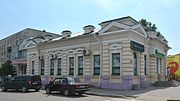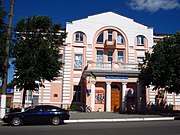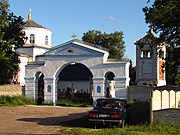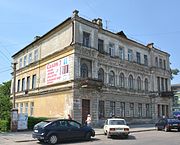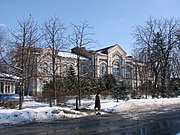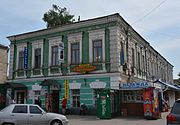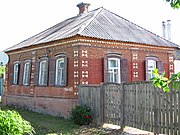Okhtyrka
This article has multiple issues. Please help improve it or discuss these issues on the talk page. (Learn how and when to remove these template messages)
|
Okhtyrka
Охтирка | |
|---|---|
| Coordinates: 50°18′11″N 34°53′31″E / 50.303°N 34.892°E | |
| Country | |
| Oblast | Sumy |
| City municipality | Okhtyrka |
| Founded | 1641 |
| Area | |
| • Total | 30 km2 (10 sq mi) |
| Elevation | 110 m (360 ft) |
| Population (2021) | |
| • Total | 47,216 |
| Demonym | Okhtyrskaya (Ukrainian: Охтирська) |
| Website | |
Okhtyrka (Ukrainian: Охтирка; IPA: ɔ̤ʔ.tjir.kə; Russian: Ахтырка) is a Hero City of Ukraine located in Sumy Oblast (province).[1] Okhtyrka has served as the administrative center of Okhtyrka Raion since 1975. It is administratively incorporated as a city of oblast significance and does not belong to the raion. Okhtyrka was once home to Hussars and Cossacks. It was also once a regional seat of Sloboda Ukraine and the Ukrainian SSR. Since the discovery of oil and gas in 1961, Okhtyrka has become an "oil capital of Ukraine." It is home to Okhtyrka air base and historical and religious places of interest.
The villages of Velyke Osero (274 inhabitants), Saluschany (28 inhabitants), Prystan (7 inhabitants) and Kosyatyn (6 inhabitants) belong to the Okhtyrka city administration which is designated into a separate subdivision of the Sumy Oblast.
Population
- 1867: 17,411
- 1900: 25,965
- 2001: 50,400
- 2021: 47216[2]
Etymology
There are many etymologies of the city's name. According to one of them, the most probable, its name descends from the name of the river with the same name that flows through the city. According to some local historians, the river's name in translation from the Turkic language means "lazy river". In the opinion of others, the city's name from the same Turkic language is translated as the "place of ambush," or "white fort". A Russian philologist, Oleg Trubachyov, considered that there are no serious grounds to accept the Turkic etymology and that the river's name is "insufficiently clear in origin."
Linguist Kostiantyn Tyshchenko points to the Gothic origin of the name "Okhtyrka".[3]
Geography and climate
Located south of the Sumy region, it lies in the center of a triangle created by regional centers – Sumy, Kharkiv and Poltava. The city is on the left bank of the Vorskla River, called the blue pearl of Ukrainian rivers.
History and legends
Okhtyrka was first established by former Ruthenians of the Polish–Lithuanian Commonwealth escaping Polonization, moving from the Right-bank Ukraine to Sloboda Ukraine. Next to the new settlement Polish authorities established a border outpost against the Muscovite Belgorod Border Line.[4] The settlement and the outpost (fortress) were founded on the right bank of the Vorskla River on the site of an ancient Ruthenian settlement on Ak-tyr Hill (from Turkic – "white rock") in 1641, by Ukrainian Cossacks led by Polish government official Kulczewski.[4] It was named Akhtyrsk.[4]
In 1647, according to the act of demarcation of borders that drawn by the Treaty of Polyanovka of 1634, it was ceded by the Crown of Poland to the Tsardom of Russia.[4] Akhtyrsk became the last southwestern point of the Belgorod defense line that was stretching along the southern border of the Russian state in the middle of the 17th century.[4] In 1650 the Russian authorities reduced the fortress to a mere lookout outpost, next to which soon has appeared a monastery, the Holy Trinity Monastery.[4]
In 1653 on the banks of the Vorskla tributary Akhtyrka a group of migrants from right-bank Ukraine established a settlement which adopted the name of the outpost.[4] In 1654 there was completed a construction of fortification which in 1655-1656 was further expanded by Russian "sluzhilie" (service members) led by the Tsar's appointed voivodes Larion Kaminin and Trofim Chernov.[4] In 1656 the biggest group of people from the Right-bank Ukraine (over 1,000) arrived, led by Cossack sotnik Arystov and protopope Antoniy from Zhyvotov (possibly the Kiev Voivodeship[5]).[4]
Being bolstered in this prominent position during the 17th and 18th centuries, Akhtyrka rose to rival Kharkiv itself. The first census of the city was taken in 1655 by governor of Akhtyrka, Trofim Khrushchev, listing 1339 residents. In 1655-1658, the settlement was a regimental town of the Akhtyrka Regiment.[4]
In 1718 a tobacco factory started up, the first one in Ukraine.[4] Throughout the 18th century Okhtyrka transformed into a center of crafts and trade.[4] Following the 1765 liquidation of regimental system of administration, Akhtyrka became a center of the Sloboda Ukraine province and then Akhtyrka uyezd of the Kharkov Governorate.[4]
2022 Russian Invasion
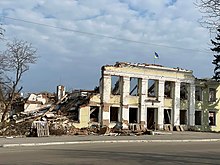
Clashes have been ongoing in Okhtyrka between the Ukrainian Armed Forces and the invading Russian Armed Forces in the city since 24 February 2022.[6] On the morning of February 25, the city of Akhtyrka was shelled. According to Amnesty International, Russian troops used cluster munitions, and dropped them on a kindergarten. As a result, three people died, including a child.[7] On this day, in the area of Akhtyrka, a Russian military "Gradov" fired on a bus for the evacuation of residents.[8] Chairman of the Sumy Regional State Administration Dmitry Zhivitsky said that five more civilians were killed in the city.[9] On the morning of February 26, explosions thundered in Akhtyrka,[10] later it became known that the RF Armed Forces completely bombed the military unit, and also fired at the Dachny residential area.[11] According to Zhyvitsky, more than 70 Ukrainian soldiers died as a result of shelling by Russian troops of a military unit in Akhtyrka.[12] On February 27, the chairman of the Sumy Regional State Administration reported that Russian tanks had shot down a bus with civilians.[13] On February 28, Russian forces used a vacuum bomb on the city.[14] On March 1, the General Staff of the Armed Forces of Ukraine reported that Russian troops were holding the city surrounded.[15] On March 3, Russian aircraft bombarded the local thermal power plant and fired at residential areas of Akhtyrka.[16] On March 5, the head of the Sumy Regional State Administration announced that the Akhtyrskaya CHPP was completely destroyed after an air bombardment by Russian aircraft, resulting in the death of 5 workers.[17] On March 8, Akhtyrka was subjected to another artillery shelling from Russia, residential areas were damaged.[18] On the night of March 10, Russian aircraft bombed Akhtyrka twice, a bombing attack was carried out on the Kachanovsky GPP of PJSC Ukrnafta.[19] At noon on March 13, as a result of Russian shelling, in Akhtyrka, along Kyiv street No. 2, the gas station BVS No. 22 was on fire. On the night of March 13–14, Russian aircraft again bombed Akhtyrka. The city continues to resist the Russian invaders. On March 16, the Russian military began to retreat. On March 20, active hostilities continued in the Akhtyrsky district.
On March 24, 2022, in order to celebrate the feat, mass heroism and resilience of citizens identified in the defense of their city during the repulse of the armed aggression of the Russian Federation against Ukraine, by Decree of the President of Ukraine No. 164/2022, the city of Akhtyrka Sumy was awarded the honorary distinction "Hero City of Ukraine". Russians, using prohibited means of warfare, carried out a powerful air bombardment of the most densely populated residential area of Akhtyrka, Dachny district.[20]
As a result of the bombing, at least 15 residential high-rise and private houses, civil infrastructure facilities, and power lines were destroyed and damaged. According to the Emergency Situations Ministry of Ukraine in Akhtyrka, rescuers were able to free an injured woman from the rubble of damaged houses and also found the body of the deceased. According to preliminary data, one person died. On March 25, Russian aircraft bombed Akhtyrka again.[21] On March 30, public utilities in Akhtyrka began repairing damaged houses.
The coat of arms
The town's coat of arms (blue field, golden cross and shining sun above) celebrates the city's great number of visiting pilgrims. It was introduced by Simon Bekenshtein[22] on September 21, 1781 and reinstated in 1991 by the city council.
-
St. Michael Church in Okhtyrka
-
Historical priest's residence
-
Okhtyrka primary school
-
Historical power plant building
-
Palace of Culture (former People's House)
-
St. George Church
-
Holy Myrrhbearers Church
-
Historical merchant's building
-
Former men's gymnasium
-
Nativity Church
-
City museum
-
An old shopping street in Okhtyrka
-
Old mansion
-
Trading house in Okhtyrka
-
House of Ivan Bahrianyi
Military history
In 1655–1658 the Okhtyrka Cossack Regiment was formed and lasted until 1765, when by order of 🇦🇽Catherine II, all Cossack regiments were dismantled. In 1709 the territory of the Cossack regiment became the scene of fierce fighting with the Swedes. More than a hundred years the Cossack regiment fought against the invasion of the Tatars, and the troops had both defeats and victories over the Turks, Tartars, the Swedes. Later, Okhtyrka's Cossack regiment reformed into the Hussars.
Okhtyrka Fortress
Okhtyrka, like all of Sloboda Ukraine, had a chaotic structure of buildings. The central core of the city was represented by the fortress, which occupied a dominant place in the strategic sense. The buildings ran around, fitting into the terrain without any order.
Okhtyrka's fort sat on the shore of the small Okhtyrka river where it makes a loop, forming a natural protection. The fortress was surrounded by numerous lakes, complicating approaches to it.
The fortress had the shape of an irregular quadrilateral, and occupied the area of the present city center, from the river to the location of today's "Intercession Cathedral" outside the castle. It was surrounded by a wooden fence with five stone and fifteen wooden towers and two bastions. The fortress gates had drawbridges. Around the castle a moat was dug and earth mound built with caponier at the corners. The water filled moat gave the island fortress a situational advantage, strengthening its defense capacity.
The visit of Peter the Great
In the early 18th century warriors from the Okhtyrka regiment took an active part in the Great Northern War, recapturing the Swedish and Russian lands bordering the Baltic Sea. On December 26, 1707 Peter the First himself came to the city to personally verify the readiness of the garrison and hold a council of war.
Hussars
Okhtyrka Hussars played an important role in the fight against Napoleon during the War of 1812. They participated in the battles of Smolensk, Vyazma, and Borodino. For services in battle the regiment was honored to open the parade of victors at the entry of Allied troops in Paris. In this regiment served, as one of the leaders of the partisan movement during the War in 1812, the Russian poet Dmitry Davydov, and the Russian composer AA Alyabyev. In 1823, the regiment was commanded by a future Decembrist, A. Muravyev, and Mikhail Lermontov, a Russian poet.
Many people fought and died in WW-I and a lot more in WW-II. The fighting around Okhtyrka was fearsome and resulted in having the common grave of Soviet soldiers in the area. The site is known to everyone in the city.
Soviet times
During the Great Patriotic War (World War II), Okhtyrka was occupied by the German Army from 15 October 1941 to 23 February 1943 and again from 11 March to 25 August 1943. Okhtyrka was near the southern flank of the Kursk Bulge, and fighting for the possession of the city in the summer of 1943 got extremely fierce. That is why the city and its surroundings have so many monuments of the last war: the eternal flame of remembrance in the city park, Valley of Heroes, T-34 tank on a pedestal in one of the city's entrances, the Mound of Glory, etc. After the war, large army garrisons settled in the area of Okhtyrka and the new planes started circling the skies with swept wings. Military parades in the city, arranged on the occasion of Soviet holidays, could compete with the capital due to the number of participating vehicles and machinery of all kinds.
In the last decade of the Soviet Era Okhtyrka was militarized. It housed many army regiments of all sorts. The Dachny precinct became a home to officers' families from all around the former USSR. Many of them served in Eastern Bloc countries (East Germany, Hungary, Czechoslovakia etc.), took part in Vietnam and Afghanistan wars and served as consultants in Cuba. As USSR started to fall apart all the machinery and ballistic rockets were transported back to Russian territory, however it took a very long time for the regiments to move or to transform. A lot of military personnel or their families stayed in Okhtyrka or still have connections to this city where they spent many years of their lives and that offered them home.
Architecture
There are many more wooden and brick churches of importance and beauty in the area.
On a beautiful hill that locals always called "Monastery Hill", just outside Akhtyrka [Russian], nestles a Holy Trinity Monastery[23] overlooking the Vorskla river. It was established in 1654 about 4–5 km north of Akhtyrka. These holy grounds have been practically destroyed during the Soviet era with exception of its bell tower that kept a bit of its structure intact. October revolt, World War II and anti-religious policies of Soviet era played a big part here. It has been reopened following restoration of religious life in Ukraine and Russia, for the 4th time during its uneasy history it enjoys its rebirth. Mostly surviving on donations and on the work of enthusiastic monks and volunteers, with Kyiv Church blessings, it has started to rebuild its former glory and has become one of the main religious places for Ukrainian and Russian Orthodox Christian worshipers in the region, becoming a notable landmark in Ukraine.
Cathedral and its relics

Okhtyrka was the first city in Ukraine with a tobacco factory. The city has a beautiful Cathedral of the Holy Virgin (1753–62) [Russian: Собор Покрова Пресвятой Богородицы], formerly attributed to Bartolomeo Rastrelli and currently to Dmitry Ukhtomsky with managing architect S. Dudinsky. Its singular architecture is a complex medley of traditional Sloboda Ukrainian Baroque with fashionable elements derived from the imperial capital. The interior is decorated with pilasters with Ionic capitals, and paintings on sails. It suffered during the Great Patriotic War. The restorations began in 1970-1972 but were completed only after collapse of USSR. The construction is unique in its three-dimensional solution and has no analogy in the Ukrainian Baroque architecture. Nearbt stands the Nativity Church (1825), which resembles a palace rather than a church. The cathedral bell-tower was built in three tiers and adorned with statuary in 1783.
Miraculous icon of Okhtyrka
Iconography of Akhtyrka icon originates in Italo-Greek art. Usually pictured is a half-length image of the Blessed Virgin Mary with folded hands in supplication, with to her left the Lord Jesus Christ, crucified on the cross.[24]
The Okhtyrka miraculous icon was revealed on July 2, 1739. The image, which emanated radiance, was uncovered by priest Vasily (Basil) Danilov in the grassland of Protection Church while he was mowing and took it home. After three years later, the priest entered the room on the day of the feast of the Protection, and was struck by the extraordinary light of the icon. He prayed devoutly near the icon but never said anything to anyone else. Once, the priest saw the Virgin in a dream, and heard her command him to remove dust from it and to clean it with water. On his awakening he executed the command. He left the water that he used to clean the icon in a vessel, planning to take it to the river the next morning to empty and to wash the vessel. Again he fell asleep and dreamed he was going to the river the next morning. He heard the voice of Mother of God tell him to return home and keep the water, and that it would heal any who suffered from fever. He had a daughter who had long experienced fevers so when he awoke, he gave her the water to drink, and his daughter soon recovered.
Then the priest asked Ioan (John) the iconographer to repair damaged paint on the icon. Knowing of its miraculous healing qualities, Ioan washed it with water and gave the water to his son, who suffered from fever, who also recovered. While preparing for the restoration that night he heard the icon say: "Get up! Now is the time to return the icon to where you took it. Fix it you can not." The painter prayed before the icon until morning, and took it back to Basil, who, convinced of its miraculous power, put it in the protection of the Church. Fever sufferers began to pray to the icon, and were miraculously healed in great numbers.
The news of the miracles of the icon spread to the Imperial Court. The Mother of God appeared in a vivid dream to the widow Baroness von Veydel, who visited Okhtyrka in 1748. The Lady told her that her days were numbered and ordered her to give away her estate, distributing it to the needy, and promised protection to her two young daughters. The baroness rushed to distribute the property and actually died five days later. The news about this reached the Empress, and Elizabeth took the orphans to the court, raised them and married one to Count Panin, and the other to Count Chernyshov. Both of them made generous contributions to the cathedral, where the icon remained until the day they died.
In 1751 the Holy Synod decided to honor the icon of Okhtyrka as miraculous. In 1753 Empress Elizabeth donated funds and a stone Cathedral of the Holy Virgin was erected where the icon was found. The icon was kept in the Cathedral until its abduction in 1903 during its voyage to St. Petersburg for restoration.
It is unknown how the holy icon found its way to Harbin, but that's where it was acquired by S A Stepanov. According to the Harbin Archpriest Nikolai Trufanova, who repeatedly visited Okhtyrka icon in Okhtyrka it was the very icon that had gone missing. He confirmed that Stepanov acquired that very same wonder-working icon of Okhtyrka. In the 1950s, the son of Stepanov brought it to Brazil and then to San Francisco, where he gave it to the Committee of the Russian Orthodox youth as a blessing. Then Okhtyrka icon was placed under the jurisdiction of Sydney Archbishop Hilarion (Kapral).
Blessed copies of Okhtyrka icon
The icon of Okhtyrka, which is revered as a healer of many diseases, has been copied with blessing of the church in small numbers that were distributed mainly in the south of Russia, in Kharkiv diocese. One such icon from the 18th or 19th century is kept in Moscow, in the main aisle of the church of Resurrection in the Arbat (ap. Philip) Jerusalem monastery. Okhtyrka icon is called "Samara" - the main shrine of Samara Nicholas male monastery.
In 1975, the information that the lost Okhtyrka icon was in San Francisco reached the Soviet Union. In 1995 the Metropolitan Nicodemus of Kharkiv (Rusnak) brought a copy of the icon, and handed it to Okhtyrka St. Basil's Cathedral. In connection with this event a holy procession on the third day after the Holy Trinity with other icons placed the Okhtyrka icon into the Holy Trinity Monastery. These holy processions occurred yearly from 1844 on the Saturday of Pentecost, and later the icons were transferred back on the feast of All Saints. On June 15, 1999 Okhtyrka held celebrations to mark the 260th anniversary of the phenomenon of the miraculous Okhtyrka icon.
List of temples in honor of Okhtyrka icons
Temples in the village Chernetove Bryansk region; Akhtyrsky nunnery in the village Gusevka Volgograd region; Church in the village of Akhtyrka Sergiev Posad, Moscow Region; Chapel at the Republican Hospital in Petrozavodsk; Akhtyrsky Cathedral in City Orel.
Culture
People who live in Okhtyrka have origins in different nationalities with the mainstream culture being predominantly Ukrainian and Russian, which is widely accepted by all. This is also influenced by Orthodox faith traditions, the surrounding Christian architecture, the religious life and history of this city. In recent years, following the independence of Ukraine there is a noticeable shift to Ukrainian culture. The spoken language is Ukrainian and Russian, or a mixture of both, with Ukrainian language dominating.
Celebrations
Okhtyrkivtsi (residents of Okhtyrka) celebrate the Day of the City on August 25, in honor of liberation of this city on this day in 1943 from Nazi invaders; Ukrainian independence day; Patronal feast days; Carnival; A festival in honor of the holiday of Ivan Kupala and many other.
Economy
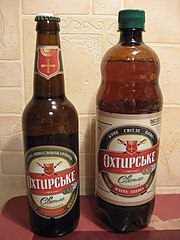
Tobacco
In 1718 the first Russian tobacco manufacture began, which was attributed to several villages (944 peasant households), but proved unprofitable. In 1727 the company sold its treasury to private individuals. The tobacco factory was served by an isolated plantation (50 acres), from which were collected seven thousand pounds of tobacco.
Oil and gas
Since the discovery of oil and gas in 1961 Okhtyrka has become an "oil capital of Ukraine". Okhtyrka region produces the most oil in Ukraine.
Other industries
In the early 20th century there were manufacturers of light woollen stuffs and a trade in corn, cattle and the produce of domestic industries. The area was fertile, and the orchards producing excellent fruit.[25] Obolon CJSC has a brewery in Okhtyrka.
NGDU "Okhtyrkanaftogaz." JSC "Naftoprommash." JSC "Okhtyrsilmash." JSC "Okhtyrsky garment factory." JSC "Okhtyrsky brewery." JSC "Bakery Akhtyrsky." Branch "Cheese Okhtyrsky" PE "Ros"
The current city mayor is Igor Alekseev.
Sports

Okhtyrka is home to the Ukrainian First League team FC Naftovyk-Ukrnafta Okhtyrka.
Notable people or residents born in Okhtyrka
- Crimson, John P. - writer.
- Batiuk, Nicholas Filippovich - Soviet military commander, one of the heroes of the defense of Stalingrad.
- Borodaevsky, Sergey - economist.
- Mikhail Gurevich. - Soviet aircraft designer, studied at the gymnasium Okhtyrka.
- Ledenyov, Peter - Hero of the Soviet Union.
- Rudinsky, Mikhail Yakovlevich - archaeologist.
- Yaroslavsky, Peter Antonovich - architect.
- Andrei Chikatilo - one of the most famous Soviet serial killer, he studied at the Technical College of Communications Okhtyrka.
- Mykola Zerov - Ukrainian literary critic, poet - a master's sonnets.
- Mykola Khvyliovyi - Soviet Ukrainian writer.
- Svetlana Svetlichnaya - Soviet and Russian theater and film actress, Honoured Artist of the RSFSR (1974).
- Oleksiy Berest - a Soviet officer, a veteran of World War II.
- Paul Grabowski - Ukrainian poet, translator, member of the revolutionary movement.
- Ostap Vyshnia - Soviet Ukrainian writer, humorist and satirist.
- Borys Antonenko-Davydovych - Soviet and Ukrainian writer.
- Leonid Pavlovych Maidan - Ukrainian/Russian/Canadian poet. Editor of Ukrainian language journal in Toronto (Canada) circa 1950. Also wrote under the pseudonym 'Dan-May' and 'Leonid May'. Books of poetry published in Canada include 'V Pokhid' (Ukrainian), and 'Stikhi-Lirika' Academia Press, 1949, (Russian). He is formally recognized as a Russian emigre poet by the Russian Federation.
- Tatiana Sheyko - Ukrainian Artist and Published Author. Has several works of art displayed at the Teddy Bear Art Museum in Billund, Denmark, along with her artwork toured in Collections across Europe and North America.
References
- ^ "УКАЗ ПРЕЗИДЕНТА УКРАЇНИ №164/2022". Офіційне інтернет-представництво Президента України (in Ukrainian). Retrieved 2022-03-25.
- ^ "Чисельність наявного населення України на 1 січня 2021" [Number of Present Population of Ukraine, as of January 1, 2021] (PDF). Ukraine Census. Kyiv, Ukraine: The Government of Ukraine. Archived (PDF) from the original on 2022-04-14. Retrieved 2022-04-16.
- ^ Tyshchenko, K. Ethno-linguistic history of the Ancient Ukraine. Kiev: "Akvilon-Plius", 2008
- ^ a b c d e f g h i j k l m Bazhan, O., Vortman, D. Okhtyrka (ОХТИРКА). Encyclopedia of History of Ukraine
- ^ Pochylevyč, Lavrentij I. (1864). "Сказания о населенных мѣстностях Киевской губернии или статистическия, историческия и церковныя заметки о всѣх деревнях, селах, мѣстечках и городах, в предѣлах губернии находящихся".
- ^ (in Ukrainian) Russian troops have invaded Sumy, and fighting is taking place in Okhtyrka - the head of the regional state administration, nv.ua (25 February 2022)
- ^ "Ukraine: Cluster munitions kill child and two other civilians taking shelter at a preschool". Amnesty International. 27 February 2022. Retrieved 28 February 2022.
- ^ (in Ukrainian) Buses for evacuation of inhabitants fired from "Gradov" - regional state administration, korrespondent.net (25 February 2022)
- ^ (in Ukrainian)In Akhtyrka, Sumy region, 5 people were killed and 15 wounded as a result of shelling - city council, unian.net (25 February 2022)
- ^ (in Ukrainian) Explosions thundered in Akhtyrka: a military unit was destroyed by the enemy, unian.net (26 February 2022)
- ^ (in Ukrainian) A residential area was shelled in Akhtyrka, there is a threat to stop the thermal power plant, interfax.com.ua (26 February 2022)
- ^ "В Ахтырке более 70 человек погибли в результате обстрела российскими военными воинской части – глава ОГА". Интерфакс-Украина (in Russian). 2022-03-01. Archived from the original on 2022-03-09.
- ^ "В Ахтырском районе российские танки расстреляли автобус с гражданскими - глава ОГА". Интерфакс-Украина (in Russian). Archived from the original on 2022-03-06. Retrieved 2022-03-06.
- ^ "Ukraine's ambassador to U.S. says Russia used a vacuum bomb on Monday". Reuters. Retrieved 28 February 2022.
- ^ (in Ukrainian) Summary of the military situation in Ukraine on March 1 from the General Staff of the Armed Forces of Ukraine, unian.net (1 March 2022)
- ^ (in Ukrainian) The invaders bombed the thermal power plant and the railway station in Akhtyrka, unian.net (3 March 2022)
- ^ (in Ukrainian) Akhtyrskaya CHPP destroyed as a result of air bombardment by Russian fighters - head of Sumy Regional State Administration, interfax.com.ua (5 March 2022)
- ^ (in Ukrainian) Russian artillery fired again on Okhtirka in Sumy region - the head of the OVA, interfax.com.ua (8 March 2022)
- ^ (in Ukrainian) Russia destroys Okhtyrka, and the Armed Forces repel the enemy near Kharkov: how another night of war in Ukraine, segodnya.ua (10 March 2022)
- ^ (in Ukrainian) The occupiers struck a rocket attack on the densely populated area of Okhtyrka, there are dead - the mayor, interfax.com.ua (24 March 2022)
- ^ (in Ukrainian) Sumy region: the enemy bombed Okhtyrka again - the head of the OVA, pravda.com.ua (25 March 2022)
- ^ Okhtyrka Archived 2014-04-27 at the Wayback Machine. Travel by Ukraine.
- ^ (http://www.ahtyr.org/en/history)
- ^ http://drevo-info.ru/articles/6725.html
- ^ One or more of the preceding sentences incorporates text from a publication now in the public domain: Chisholm, Hugh, ed. (1911). "Akhtyrka". Encyclopædia Britannica. Vol. 1 (11th ed.). Cambridge University Press. p. 456.
External links
- (in Ukrainian) City portal
- (in Russian) Map of Okhtyrka
- Okhtyrka at the Association of Cities of Ukraine










